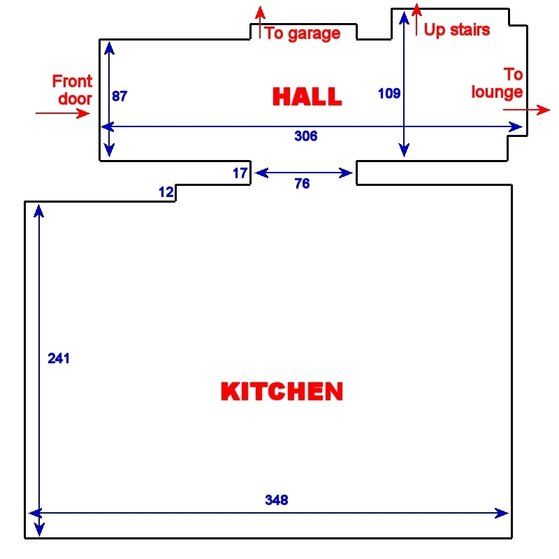mediamonkey
TF
Hi everyone, this looks like a knowledgable place to get some advice!
I am planning to totally redo my kitchen this summer, in a 1960s end-of-terrace that hasn't had a new kitchen since it was built. As you come into the house, the door into the kitchen opens off to the right, halfway down the entrance hall. At the moment the hallway is carpeted and the kitchen has vinyl tiles which I put down two or three years ago as a temporary (ha!) fix to replace old plasticky/lino tiles which had been under a carpet and were breaking up. Subfloors are concrete and looked pretty sound and level in the kitchen; I haven't pulled up the hall carpet to investigate the condition yet.
I'll be fitting the kitchen units myself but getting professionals in to do electrics, plumbing and tiling, and I'll be totally ripping out everything in the kitchen back to an empty room.
So, questions....
1) What size of tiles would you recommend for a narrow hallway (300cm long by 87cm wide, approx) with a small kitchen (about 350cm x 240cm wall to wall, so considerably less floor area once units are in on three walls!). Total area including doorways etc is just under 12 sq m. The nicest ones we've seen so far in our price range are Gemini beige which are half price (just under £30/sqm down from £60) but they are massive - 90cm x 45cm. I know large tiles can make small areas seem bigger, and the fewer joints the better from an aesthetic point of view, but is this just too big and would fitting them in such a small space be a major nightmare for a tiler with cuts etc?
2) Is it best to tile wall-to-wall in the kitchen and then put the units in on top, or install units then tile up to the legs and fit plinths? I have read arguments for both - my feeling is to go wall to wall as it makes any future changes of kitchen layout less of a hassle if you have a finished floor throughout.
Oh and 3) how much prep is generally required for concrete floors assuming they are sound and reasonably level? Or is it a case of "it depends"? Basically I just want to be aware of any potential hold-ups eg waiting for a new surface to dry before it can be tiled, as this would affect the whole schedule.
I'll come to wall tiles later... :dizzy2:
I am planning to totally redo my kitchen this summer, in a 1960s end-of-terrace that hasn't had a new kitchen since it was built. As you come into the house, the door into the kitchen opens off to the right, halfway down the entrance hall. At the moment the hallway is carpeted and the kitchen has vinyl tiles which I put down two or three years ago as a temporary (ha!) fix to replace old plasticky/lino tiles which had been under a carpet and were breaking up. Subfloors are concrete and looked pretty sound and level in the kitchen; I haven't pulled up the hall carpet to investigate the condition yet.
I'll be fitting the kitchen units myself but getting professionals in to do electrics, plumbing and tiling, and I'll be totally ripping out everything in the kitchen back to an empty room.
So, questions....
1) What size of tiles would you recommend for a narrow hallway (300cm long by 87cm wide, approx) with a small kitchen (about 350cm x 240cm wall to wall, so considerably less floor area once units are in on three walls!). Total area including doorways etc is just under 12 sq m. The nicest ones we've seen so far in our price range are Gemini beige which are half price (just under £30/sqm down from £60) but they are massive - 90cm x 45cm. I know large tiles can make small areas seem bigger, and the fewer joints the better from an aesthetic point of view, but is this just too big and would fitting them in such a small space be a major nightmare for a tiler with cuts etc?
2) Is it best to tile wall-to-wall in the kitchen and then put the units in on top, or install units then tile up to the legs and fit plinths? I have read arguments for both - my feeling is to go wall to wall as it makes any future changes of kitchen layout less of a hassle if you have a finished floor throughout.
Oh and 3) how much prep is generally required for concrete floors assuming they are sound and reasonably level? Or is it a case of "it depends"? Basically I just want to be aware of any potential hold-ups eg waiting for a new surface to dry before it can be tiled, as this would affect the whole schedule.
I'll come to wall tiles later... :dizzy2:
Last edited:

